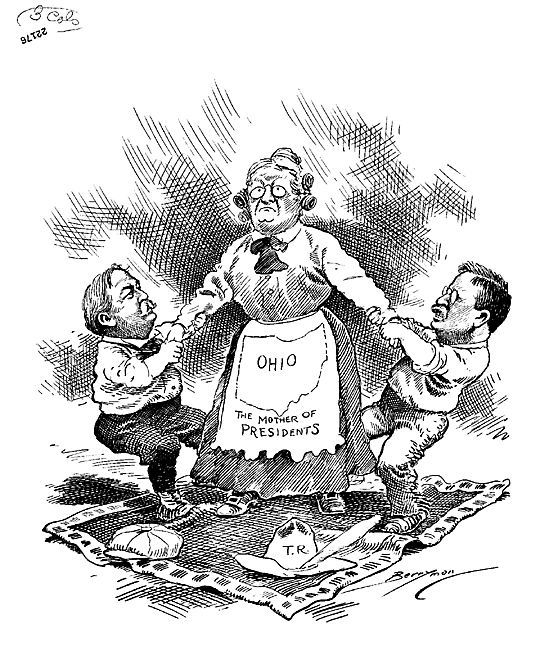 |  |  |  |
|---|---|---|---|
 |  |  |  |
 |  |  |  |
 |  |  |  |
 |  |  |  |
 |  |
A Guide to Decoding Political Cartoons
The Nastiest Cartoons in History
About the Project
The goal of this digital platform is to function as an exhibit space for some of the greatest American political cartoons. By analyzing how the interpretation of themes like racism and ethnicity, Presidential politics, gender roles, and symbols have evolved throughout modern political cartoon history, visitors to the site can learn how to decode cartoons from the past as well as today. As a demonstration of the evolution of political cartooning, this digital exhibit can function as a guide to gaining the skills it takes to understand generations of historical hilarity. This digital space will also serve to explore and describe a comprehensive evolution of modern American political cartooning by comparing the periods of work between three prolific cartoonists: Thomas Nast, Clifford Berryman, and Herbert Block.
The diverse, colorful, and occasionally problematic past of political cartoons is intriguing in its own right, but Thomas Milton Kemnitz argues in “The Cartoon as a Historical Source” that cartoons can also be used as tools to analyze the culture of the people that enjoyed them. This artistic form of public opinion provides unique insights into the relationship between current events, the people that lived through them, and the mass circulation of news. Disturbed by the lack of historical utility, Kemnitz argues, “the cartoons are frequently fascinating, but their value to historians lies in what they reveal about the societies that produced and circulated them”[1].
[1] Thomas Milton Kemnitz, “The Cartoon as a Historical Source,” The Journal of Interdisciplinary History 4, no.1 (2004): 136.
Why Political Cartoons?
The power of the pen is a theme common across all of history. The written word has been used as a tool of persuasion, frustration, motivation, and unification since its conception. Words eternalized in ink have connected distanced loved ones, crafted tales of adventure or commonplace, united individuals in their religious foundations, enacted laws, and formed countries. Undeniable to anyone with a history textbook, the pen of government has written history while the pens of individuals have created a culture and forced progress. However, there are moments in history when the pen is used to draw instead of write as a way of expressing a desire for change. In the hand of an artist, the very same utensil that has been used to write laws becomes the tool that critiques them. Instead of depending on law and verbose rhetoric, these artists rely on caricatures and symbols to persuade the masses and indict the ills of society. When pens are used as an artist’s weapon of free speech, the message becomes visual and memorable.
Whether drawn in the 19th century or the 21st century, cartoons “remind the historian of the importance contemporaries placed on seemingly insignificant events and of the relation between these occurrences, popular attitudes, and public opinion.”[1] As well, political cartoons continue to be used today to comment on the absurdity of current events in ways words can’t process. Because of the continued relevance of political cartoons throughout the last two centuries, pioneered by the genius and craft of Thomas Nast, it is only fair that these iconic examples of the freedom of speech finally receive a digital exhibit space worth their weight in ink.
[1] Thomas Milton Kemnitz, “The Cartoon as a Historical Source,” The Journal of Interdisciplinary History 4, no.1 (2004):
The Cartoonist
Similar to studying a painter, a film producer, or a novelist, it is important to learn about the individual who created the work when analyzing political cartoons. These editorial individuals, although newspaper employees by trade, are artists at their core. To help understand cartoons, its valuable to know why and how the artist drew what he did. This digital exhibit analyzes three generations of modern American cartoonists: Thomas Nast, Clifford Berryman, and Herbert Block
The History
Journalists have been reporting on current events and newspapers have been printing their articles since the printing press hit its stride. Whether summarizing events or throwing muddy gossip around as muckrackers, newspapers provide historical commentary. Political cartoons provide a visual commentary for their contemporary readers. As modern readers of cartoons, the key to decoding the drawings is to research the history
The Humor
Humor lasts a generation before it requires translation. Slang to one age can be as similar as a foreign language to an individual just 5 years older. Some punchlines are ephemeral and gags can be fleeting. While cartoons can be wholly serious, they are often crowded with caricatures, symbols, and jokes of one generation. We can learn to decode the humor in history by recognizing the common ways cartoonists made fun of people in power and conjured giggles from our ancestors